10 Rich SERP Elements You Can Leverage to Make Your Brand SERP Sexy

Originally Published on SEMrush July 05, 2019 (Jason Barnard)
Q: Who Googles a brand before they sign on the dotted line?
A: Pretty much everyone - clients, partners, distributors, suppliers, employees, investors, journalists, etc.
Q: What can you do about adding rich elements to what they see?
A: Quite a lot… read on!
Does that SERP contain 10 simple blue links or something more attractive and convincing to the user? There is a surprising amount of SERP real estate on that brand search result, you can leverage that impress on that “all-important last-step-before-I-sign.”
Here are 10 of the most achievable:
- Rich Sitelinks
- Google My Business
- Review stars
- Images
- Videos
- Twitter boxes
- Search Box
- Knowledge Panel
- Wikipedia
- Top stories
Throughout this article, bear in mind that I am only talking about the search results that come up for brand name related searches. The timeframes are there to give you an idea of what you might expect - Fast means a few weeks; Medium means a few months, and Slow means a year or more.
Rich Sitelinks
Fast
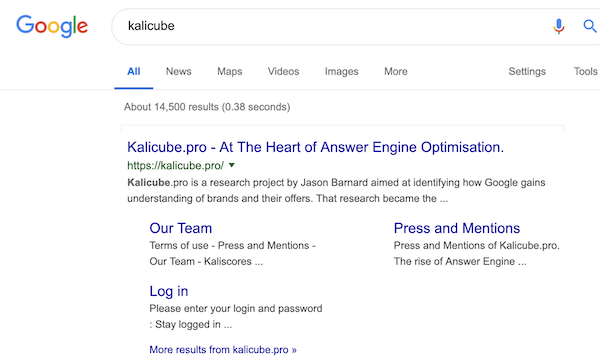
Without these on your brand SERP, you look distinctly amateur. With them, your brand looks like it should be taken seriously. Getting this element is the absolute minimum (and the first thing to aim for). As things stand right now, there are no rules or tactics that will specifically get you rich sitelinks. Google doesn’t tell you how to create rich sitelinks or control their appearance directly. But it basically comes down to correctly organizing your site so that Google has something meaningful to show.
Extra links to internal pages of your site that clients and prospects will find useful. So, have a specific landing page for each language, and easily identifiable pages for prices, login, about us, jobs, contact us, press, and other brand-centric pages. Here are some tips to get started.
Google My Business
Fast
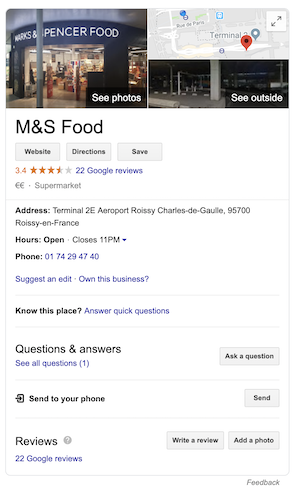
This option is an easy element to control and optimize. Claim your business, update all the information that you can including opening hours, photos, telephone, description, the area served, category, and website, and also add common customer questions with a clear answer for each.
Here is a helpful article by Eric Shanfelt. Lastly, make sure you update photos regularly (say, once a month), and get positive reviews from happy customers; this will ensure it always looks its best.
Review Stars
Medium

Having review stars appear on your brand SERP requires that you have sufficient reviews (hopefully, positive) on a platform that ranks well on Google. Use SEMrush (or another tool of your choice) to check which ones have the most organic presence in your country and your market - check the leading review platforms in your country, but also the review platforms that rank for your competitors. Choose one or two (above that and you are likely to dilute the effect) and encourage your clients to give reviews on those platforms.
Over time, and with volume, your brand’s page on those platforms will rise to the top. Potentially even pushing down other platforms with less good reviews. It is important to remember that unhappy customers almost always leave a bad review, while happy customers rarely leave a review. Encourage your satisfied customers, and you will even up the scales. It takes time, but it is an easy task, and it always pays if you truly DO provide a great product and service.
Videos
Medium (if you publish regularly and get high engagement)
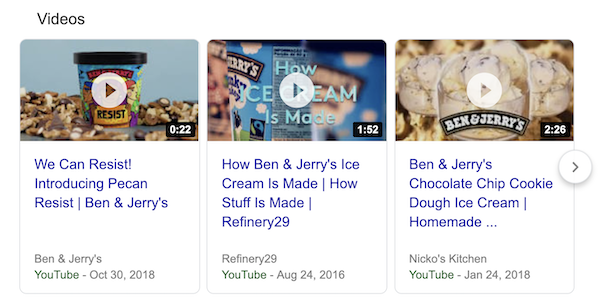
Google typically shows videos from YouTube and Facebook. In my experience, YouTube is vastly dominant. Surprisingly the reason is not so much that it is a Google platform (although that arguably plays a rôle), but more because YouTube has good SEO.
If you look at how ranking works (see the link at the bottom of this article), then you will understand that Google has an algorithm that seeks to place a relevant video onto your brand SERP. It doesn’t matter if it is hosted on Facebook, Vimeo, or Youtube. The question is, how relevant is the video content the Google video-bot has indexed. Regularly releasing video content that is relevant and has good engagement metrics is the tactic to pursue here. I publish on YouTube simply because it is simple, there is a vast pool of potential users (billions of searches on YouTube every day), and we know that (Google-friendly) SEO is baked into the platform.
Images
Fast

A row of attractive images will add immense sexiness to a brand SERP. Obtaining them is far from easy. It requires:
- That your brand is image-friendly (so things like ice cream and clothing are good candidates, while SaaS companies could have a harder time).
- That you have a wide range of quality images on your site, but also on other sites, and that they are well-optimized for image search.
If you fulfill the first requirement, then to get images in your brand SERP, you should ensure that the images on your site are not just optimized, but also driving impressions (and clicks). Also, make sure you are helping your partners with their optimization strategies for the branded images of yours that they display on their sites.
I am using Ben and Jerry’s as an example because it is exceptional and shows how much can be achieved with a stellar media strategy. They have managed to get not only the rich images result discussed above, but they also have multiple videos and have created a video carousel rich element. Wow.
Twitter Boxes
Medium (if you publish regularly and get high engagement)
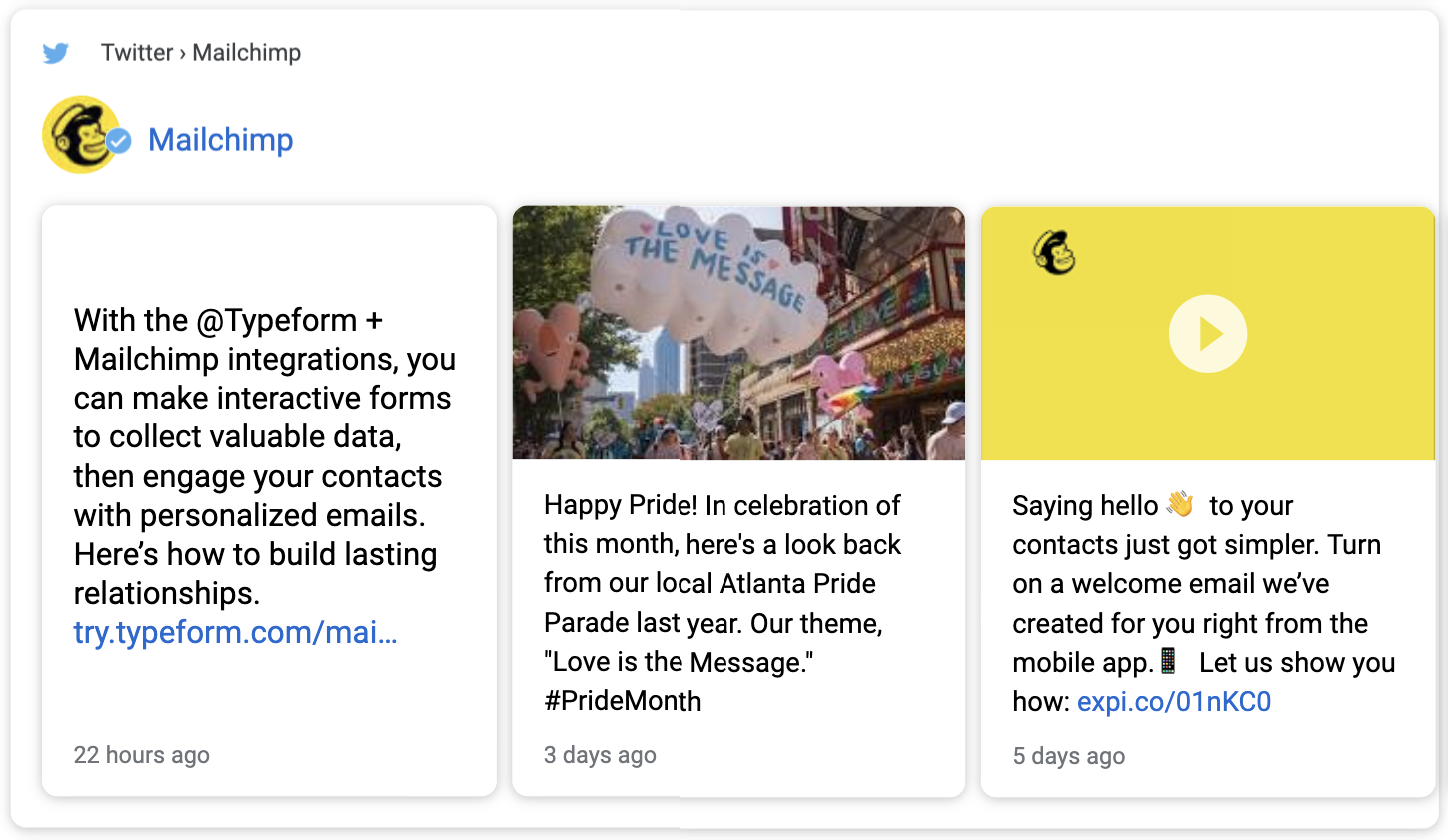
Getting these boxes is a BIG win since it occupies a large amount of real estate. It is filled only with your feed and is updated in seconds - meaning you have an incredible level of control. Getting these Twitter boxes requires sustained work on your part; every case is different since we all start from a different stage on the social platformm and each brand SERP is unique.
Once you have obtained the Twitter boxes, freshness seems to be the most critical factor (obviously you must remain on-topic and retain decent engagement). The Twitter boxes will disappear if there is a lack of activity; how long the timeframe is depends and varies, case-by-case. For me, it is one day. I have seen other brands where Tweets still show several days after the last Tweet. Minimum once a day seems to be a reasonable and safe bet.
Search Box
Fast (if your site has a lot of pages and is well-organized)
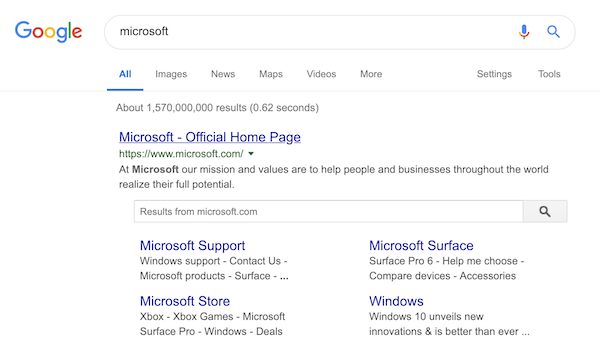
To have any chance to get this rich element, you must implement Schema.org structured markup ( “@type”: “SearchAction”), learn about it here. However, even with the correct code, there is no guarantee. Google will show the search box only if it perceives that the search box will make life easier for users. A small site with little content is not a good candidate.
Knowledge Panel
Slow
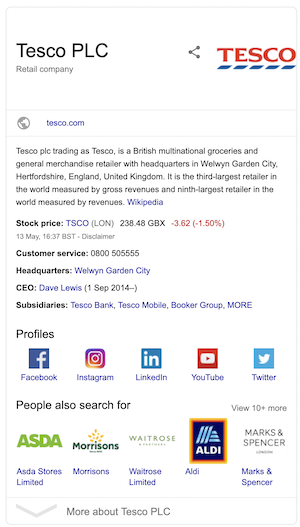
This box displays the information Google has on your brand in the Knowledge Graph. For the moment, this is mostly limited to the bigger brands with a Wikipedia page. But that is changing very quickly, and more and more brands are obtaining a place in the Knowledge Graph (and thus a Knowledge Panel) without a Wikipedia page.
The tactics to achieve this are to ensure that Google is 100% confident that it has understood who you are and what you do. Start with Schema.org markup on your About-Us page, then have each piece of information you give corroborated by at least 20 trustworthy and relevant external sources. Xin Luna Dong talks about trust based knowledge. That is the key. Google accepts as fact (or knowledge) only when that information has been corroborated by multiple trusted sources.
Here is an interview I did about the Knowledge Graph if you want to know more.
Wikipedia
Fast (if your brand is truly noteworthy, and completely unpredictable if it isn’t)

This SERP result looks great on a brand page. It is not necessarily a rich element in that it comes from the classic blue links, but I am including it because it can bring a sizeable amount of valuable information (as you can see with Yoast) and it has such a phenomenally positive impact on brand image in people’s minds.
One imagines that having a Wikipedia page is reserved for big brands. But, with 48 employees Yoast is an example of a medium-sized business that has a Wikipedia page. Why can they have one when many more prominent brands cannot? Because they are noteworthy (Wikipedia’s term, not mine). They have changed or contributed to their industry. That is criteria for a Wikipedia page - noteworthiness. Here are the rules: do not try to add a Wikipedia page unless a) your are noteworthy and b) you can prove it.
Look at the reliable, trustworthy, and relevant references at the bottom of Yoast’s page; it is difficult to argue against theirs. Keep in mind that anyone can add a page and that human editors will check and judge whether or not a page is valid. There will be a discussion, and the page will live or die on your proven merits. It is also worth noting that it is highly probable that Yoast did not start their own page. A Yoast user who felt they are noteworthy probably did.
I have a Wikipedia page too. I did not create the page, a fan of my music and cartoons did. As a person, I am noteworthy for the music albums I have released through recognized bricks and mortar record labels and the TV series I made that aired on terrestrial TV. A self-published website or a Spotify-only release does not count (that would be too easy).
Warning – if you create a Wikipedia page and it is removed by an editor, your brand will be tagged as spammy, and you expect years of waiting (and begging) before another attempt will stick.
Top Stories
Fast (if your brand generates a lot of press)
 To get this screenshot, I couldn’t resist typing “google” into Google.
To get this screenshot, I couldn’t resist typing “google” into Google.
Since these are pulled from multiple sources, and rarely from the brand’s site, only big brands can expect to get these. A brand needs a sustained level of media coverage from many trusted media sources for this rich element to be a pertinent option on the first page of a Google search. As the name implies, for news to be news, it needs to be very fresh.
Looking at the example below, we are looking at multiple stories every day. If you are a big brand, maintain a good relationship with the media outlets that appear in Google News. For smaller brands, don’t waste time on this – it will happen the day you are genuinely newsworthy.
Special Mentions
Special mentions go to these examples that are super interesting, super exciting to many Google users but are very much outside of our control or influence.
People Also Ask
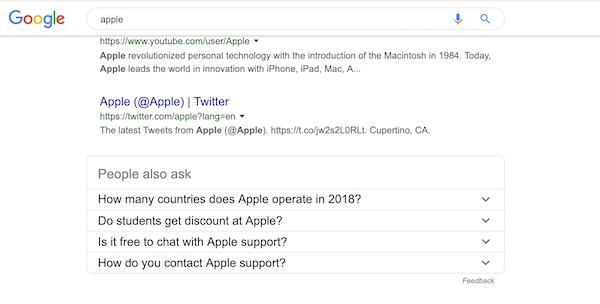
Latest from
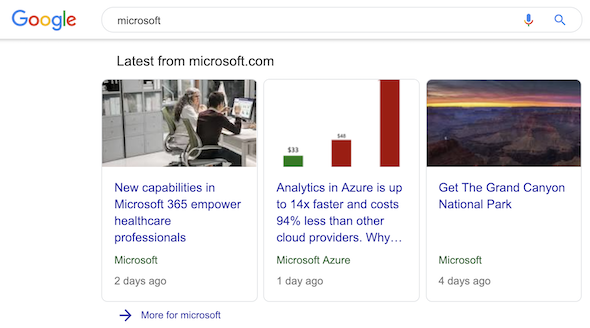
Related (oooh, some semantics / ontologies going on here)

Conclusion
I have given a quick overview with a few tips for encouraging Google to show different rich elements that a brand can reasonably aspire to. Brands can influence them all to a greater or lesser extent, but the situation is complex and unique to each element and each brand.
Each element has an algorithm behind it, each of those algorithms is based on hundreds of factors, each with a specific weighting and all these elements is competing for very limited space on YOUR brand’s page 1 SERP.
The secret has to be to know which have a real chance of making the cut for your brand and which don’t. Concentrate on those that you can reasonably expect to obtain and work on them over time. None will appear overnight. None has a quick-n-easy fix. But when you get them, your brand image looks WAY more credible to clients, partners, distributors, suppliers, employees, investors, journalists, etc. when they check up on you on Google.




